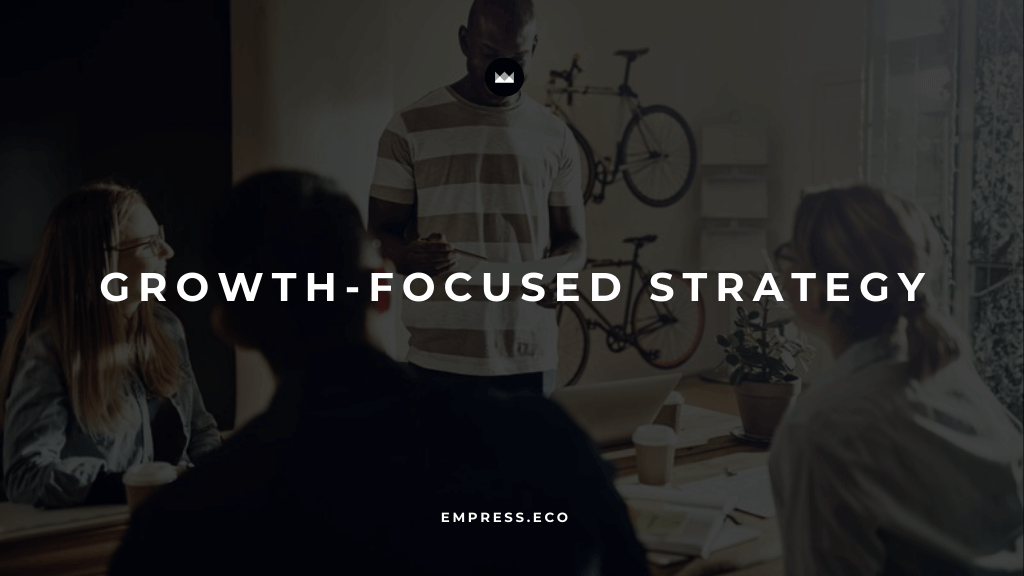
Marketing Strategy: Crafting Growth-Focused Strategies Aligned with Business Objectives
Table of Contents
A well-crafted marketing strategy is not just a nice-to-have—it's essential for achieving growth and meeting business objectives. Whether you're a startup looking to break into the market or an established company aiming to expand, aligning your marketing efforts with your overarching business goals is crucial for driving success.
In this blog post, we'll explore the key benefits of a growth-focused marketing strategy, provide a step-by-step guide to developing one, and discuss the challenges you might face along the way. By the end, you'll have a clear understanding of how to create a marketing strategy that resonates with your target audience, optimizes resources, and delivers measurable results.
Key Benefits of a Growth-Focused Marketing Strategy
1. Targeted Audience Engagement
One of the most significant advantages of a well-developed marketing strategy is its ability to target the right audience effectively. When your marketing efforts are aligned with your business objectives, you can hone in on the specific demographics, psychographics, and behaviors that define your ideal customers. This targeted approach ensures that your messaging resonates with the right people, increasing the likelihood of engagement, conversion, and long-term loyalty.
For example, if your business objective is to expand into a new market segment, your marketing strategy should focus on understanding the unique needs and preferences of that segment. This might involve creating personalized content, developing targeted advertising campaigns, or engaging with potential customers through social media platforms where they are most active.
2. Optimized Resource Allocation
Resource allocation is a critical component of any successful marketing strategy. By aligning your marketing efforts with your business goals, you can ensure that your resources—whether it's time, money, or manpower—are being used in the most effective way possible. This alignment helps you avoid wasting resources on activities that don't contribute to your overall objectives.
For instance, if your goal is to increase brand awareness, you might allocate more resources to content marketing and social media advertising, where you can reach a broader audience. Conversely, if your objective is to boost sales among existing customers, you might focus on email marketing campaigns that offer personalized promotions or loyalty rewards.
3. Increased Brand Awareness and Recognition
A cohesive marketing strategy helps build and enhance brand visibility and recognition. When your marketing efforts are consistent and aligned with your brand's values and mission, they reinforce your brand identity and make it more memorable to consumers. This increased visibility can help your business stand out in a crowded marketplace, attract new customers, and foster brand loyalty among existing ones.
For example, a company that consistently uses a specific color scheme, tone of voice, and messaging across all marketing channels will create a strong, recognizable brand identity. This consistency helps consumers associate certain qualities or emotions with your brand, making it easier for them to remember and choose your products or services over competitors.
4. Improved ROI
One of the ultimate goals of any marketing strategy is to achieve a high return on investment (ROI). By focusing on growth-oriented strategies that are closely aligned with your business objectives, you can maximize the impact of your marketing budget. When every marketing activity is designed to contribute directly to your business goals, you can expect a higher ROI and more significant results.
For instance, a company that carefully tracks the performance of its marketing campaigns and adjusts its strategy based on data-driven insights is more likely to see a positive ROI. This approach ensures that you're not only reaching your target audience but also converting them into paying customers in a cost-effective manner.
Implementing Effective Marketing Strategies
Now that we've discussed the benefits of a growth-focused marketing strategy, let's dive into the steps you need to take to develop and implement one effectively. Whether you're starting from scratch or refining an existing strategy, these steps will help you align your marketing efforts with your business objectives and drive growth.
1. Define Clear Objectives
The foundation of any successful marketing strategy is a set of clear, measurable objectives. These objectives should align with your overall business goals and provide a roadmap for your marketing efforts. When setting objectives, it's essential to use the SMART criteria—Specific, Measurable, Achievable, Relevant, and Time-bound.
For example, instead of setting a vague goal like "increase sales," a SMART objective would be "increase online sales by 20% within the next six months." This objective is specific (online sales), measurable (20%), achievable (based on past performance), relevant (contributes to overall business growth), and time-bound (six months).
2. Conduct Market Research
Market research is crucial for understanding the landscape in which your business operates. This research involves gathering data on market trends, consumer behavior, and competitor activities. By analyzing this data, you can identify opportunities and threats, understand your target audience's needs and preferences, and make informed decisions about your marketing strategy.
For instance, if your research reveals a growing demand for eco-friendly products in your industry, you might decide to emphasize sustainability in your marketing efforts. This could involve highlighting the environmentally friendly aspects of your products, partnering with eco-conscious influencers, or participating in green initiatives.
3. Segment and Target the Audience
Once you have a clear understanding of your market, the next step is to segment your audience and develop targeted marketing strategies for each segment. Audience segmentation involves dividing your broader target market into smaller, more manageable groups based on shared characteristics such as demographics, behaviors, or needs.
For example, a fitness apparel brand might segment its audience into groups like "young professionals," "stay-at-home parents," and "senior fitness enthusiasts." Each of these segments will have different motivations, preferences, and buying behaviors, so the brand would tailor its messaging and marketing tactics accordingly.
Targeted marketing strategies increase the likelihood of engagement and conversion because they speak directly to the specific needs and desires of each audience segment. This personalized approach makes customers feel understood and valued, which can lead to stronger brand loyalty.
4. Leverage Multiple Channels
In today's digital age, it's essential to utilize a mix of marketing channels to reach your audience effectively. A multi-channel approach allows you to engage with customers at various touchpoints, reinforcing your messaging and increasing brand visibility.
Some of the most effective channels to consider include:
- Digital Marketing: This includes SEO, content marketing, email marketing, and online advertising. Digital marketing is highly measurable and allows for precise targeting, making it a crucial component of any growth-focused strategy.
- Social Media Marketing: Platforms like Facebook, Instagram, Twitter, and LinkedIn offer powerful tools for reaching and engaging with your target audience. Social media marketing can help build brand awareness, foster community, and drive traffic to your website.
- Traditional Media: While digital channels are essential, traditional media such as print, radio, and television can still play a vital role in your marketing strategy, especially for reaching older demographics or local markets.
- Public Relations: PR efforts, such as press releases, media coverage, and influencer partnerships, can help boost your brand's credibility and visibility.
By leveraging multiple channels, you can ensure that your marketing messages reach your target audience wherever they are, increasing the chances of engagement and conversion.
5. Measure and Optimize Performance
The final step in developing a growth-focused marketing strategy is to continuously measure and optimize your performance. Tracking key performance indicators (KPIs) such as website traffic, conversion rates, customer acquisition costs, and social media engagement will help you assess the effectiveness of your marketing efforts.
For example, if your goal is to increase website traffic, you might track metrics like organic search traffic, bounce rate, and time on site. If you notice that your bounce rate is high, it could indicate that visitors aren't finding what they're looking for, prompting you to make changes to your content or website design.
Data-driven insights allow you to refine and optimize your marketing strategies over time, ensuring that you're always moving closer to your business objectives. Regularly reviewing your performance and making adjustments based on the data will help you maximize your ROI and achieve sustained growth.
Challenges and Considerations
While a growth-focused marketing strategy offers numerous benefits, businesses must navigate several challenges to implement it successfully. Understanding these challenges and preparing for them can help you develop a more resilient and effective strategy.
1. Adapting to Market Changes
The marketing landscape is constantly evolving, with new technologies, consumer preferences, and industry trends emerging regularly. To stay competitive, businesses must be agile and responsive to these changes. This might involve adjusting your marketing tactics, exploring new channels, or re-evaluating your target audience segments.
For example, the rise of short-form video content on platforms like TikTok has forced many brands to rethink their social media strategies. Those that have adapted quickly to this trend by creating engaging video content have been able to reach new audiences and drive growth.
2. Balancing Short-Term and Long-Term Goals
Achieving a balance between short-term results and long-term growth is one of the biggest challenges in marketing. While it's essential to see immediate returns on your marketing investments, focusing solely on short-term gains can lead to missed opportunities for sustainable growth.
A well-rounded marketing strategy should address both short-term objectives, such as launching a new product or driving seasonal sales, and long-term goals, such as building brand equity and expanding market share. By maintaining a focus on both, you can ensure that your marketing efforts contribute to lasting success.
3. Resource Constraints
Developing and executing an effective marketing strategy can be resource-intensive. Whether you're dealing with limited budgets, staffing shortages, or a lack of specialized expertise, resource constraints can hinder your ability to implement your strategy effectively.
To overcome this challenge, prioritize the marketing activities that will have the most significant impact on your business objectives. For example, if you're operating with a limited budget, you might focus on cost-effective digital marketing tactics like SEO and content marketing, which can deliver substantial returns over time.
Conclusion
A growth-focused marketing strategy is essential for businesses looking to achieve their objectives and drive success in a competitive market. By aligning your marketing efforts with your business goals, you can effectively engage your target audience, optimize resources, and enhance brand recognition.
As you develop your marketing strategy, remember to define clear objectives, conduct thorough market research, segment and target your audience, leverage multiple channels, and continuously measure and optimize your performance. While challenges such as adapting to market changes, balancing short-term and long-term goals, and managing resource constraints may arise, a well-crafted strategy will help you navigate these obstacles and achieve long-term success.
In an ever-evolving business landscape, a robust marketing strategy is your roadmap to growth, guiding your efforts and ensuring that every action you take contributes to your overall objectives. By staying focused, agile, and data-driven, you can build a marketing strategy that not only meets your current needs but also positions your business for future success.
Empress Newsletter
Join the newsletter to receive the latest updates in your inbox.



